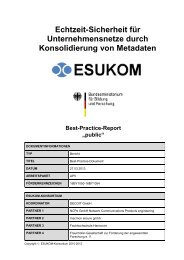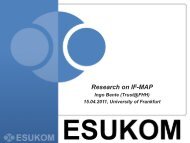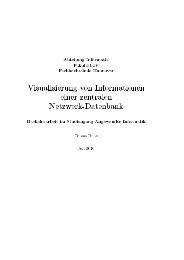Leveraging Trusted Network Connect for Secure ... - esukom
Leveraging Trusted Network Connect for Secure ... - esukom
Leveraging Trusted Network Connect for Secure ... - esukom
You also want an ePaper? Increase the reach of your titles
YUMPU automatically turns print PDFs into web optimized ePapers that Google loves.
3 Related Work<br />
Endpoint security solutions are being implemented in routers, switches, WLAN<br />
access points, software and security appliances. Authentication and authorization<br />
in<strong>for</strong>mation of mobile devices are being communicated to a policy server, which<br />
decides if the device may have access or not. Furthermore, an access protection<br />
enables a state check („health check“) of the client. Such a check typically consists of<br />
requests <strong>for</strong> specific in<strong>for</strong>mation about the client plat<strong>for</strong>m. Some of the gathered data<br />
is e.g.: version of the anti-virus software, configuration of the personal firewall, and<br />
of other software, and the patch level of the device (also of the operating system). In<br />
case that the client does not fulfil the security policy, it can be isolated into a<br />
dedicated VLAN with a consecutive „decontamination“. [3]<br />
Beside the licensed software products, “Cisco <strong>Network</strong> Admission Control (NAC)”<br />
and “Microsoft <strong>Network</strong> Access Protection (NAP)”, an open source solution exists:<br />
“<strong>Trusted</strong> <strong>Network</strong> <strong>Connect</strong> (TNC)”. For this solution, some projects implemented<br />
their own approach, like SIMOIT (http://www.simoit.de) and TNC@FHH<br />
(http://trust.in<strong>for</strong>m.fh-hannover.de).<br />
3.1 <strong>Network</strong> Access Protection (NAP)<br />
Microsoft‘s <strong>Network</strong> Access Protection is similar to the TNC functionality. However,<br />
the nomenclature of the components varies (NAP client = TNC client, TNC server =<br />
<strong>Network</strong> Policy Server (NPS), Integrity Measurement Collector is comparable to<br />
SHA (System Health Agent), and the task of the Integrity Measurement Verifier can<br />
be dispatched by the System Health Validator). [6]<br />
Similar to the TNC technology, NAP addresses the following aspects:<br />
a. Validity check of network policies: The validation of the mobile devices<br />
against policy con<strong>for</strong>mity such as the current patch level of the operating<br />
system.<br />
b. Fulfillment of network policies: Updating mobile devices, so that they meet<br />
the security policies (in an isolated quarantine network segment).<br />
c. <strong>Network</strong> access: After a positive authentication validation and policy<br />
validation, access to the network is granted.<br />
Through the so called “Statement of Health”-protocol interoperability between<br />
TNC and NAP is given. Furthermore, a licence agreement between Cisco and<br />
Microsoft allows NAP clients to communicate with both the “Statement of Health”<br />
protocol and the Cisco Trust Agent protocol. [5]<br />
3.2 <strong>Network</strong> Admission Control (NAC)<br />
Cisco’s <strong>Network</strong> Admission Control is a further architecture, which can be compared<br />
with TNC. It is an “En<strong>for</strong>cement and quarantine technology on API level”, which is<br />
integrated in the Cisco network infrastructure. Here, the trusted module “Cisco<br />
<strong>Trusted</strong> Agent” is used <strong>for</strong> user authentication and authorization. It is implemented in<br />
the mobile devices and in Cisco routers and switches. [7]





